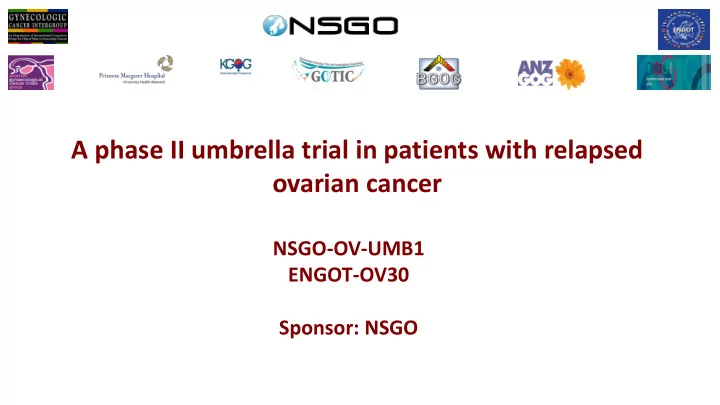

A phase II umbrella trial in patients with relapsed ovarian cancer NSGO-OV-UMB1 ENGOT-OV30 Sponsor: NSGO
A phase II umbrella trial in patients with relapsed ovarian cancer Part 1 Part 2 Cohort A n=25 MED19447 + Durvalumab MED19447 + Durvalumab NSGO Standard of Care Relapsed ovarian Treatment until Cohort B n=25 progression disease MED10562 + Tremelilumab cancer MED10562 + Tremelimumab SGCTG Standard of Care Cohort C n=25 MED10562 + Durvalumab MED10562 + Durvalumab PMHC Standard of Care Days: 1 14 28 42 56 2:1 randomization biopsy biopsy Day: < 1 Day: < 1 NSGO-OV-UMB1 CT, blood, CT, blood, blood, serum serum samples serum samples ENGOT-OV30 samples
Rationale • Immune checkpoint inhibitors have been shown to restore effective anti-tumor immunity by promoting the effector function of T-cell responses or hinder immune escape in the tumor bed. • In relapsed OC, monotherapy with PD-1/PD-L1 mAb has shown limited clinical efficacy with objective response rates of 10-15%. • Current study is exploiting new combinatory strategies: • Removing adenosine mediated immunosuppression by blocking CD73 enzymatic conversion of AMP to adenosine, thereby improving T-cell function in combination with PD-L1 mAb • Interfering with the costimulatory/inhibitory ligand-receptor network through combination of either PD-L1 mAb or CTLA-4 mAb with an agonistic antibody directed at costimulatory receptors of the Tumor Necrosis Factor receptor superfamily namely OX40
Design • Part 1 is a multicenter, phase 2, open-label non-randomized study. • The study is being conducted as an investigator-initiated study within the GCIG/ENGOT collaboration. • Each experimental cohort will be led by a different collaborative group. • This setup allows for rapid screening of additional combinations in relapsed ovarian cancer. • Part 2 will be determined according to the outcome of Part 1.
Study arm A MEDI9447: 40 mg/kg, IV, Q2W Durvalumab: 750 mg, IV, Q2W • Duration of treatment: Until progression of disease or intolerable toxicity • Response assesments: Before day 0, and then every 8 weeks. • Tumour biopsies (mandatory): Before day 0; at day 56 • Blood/Serum Samples: Before day 0 and then every 14 days
Study population • Relapsed epithelial OC with TFI chemotherapy < 6months. Patients must have received at least one series of platinum-based therapy, • or with TFI chemotherapy ≥ 6months. Patients must have received at least two courses of chemotherapy for relapsed disease where at least one these must have been platinum based, and these patients must have received all approved therapies. • HGSOC, HGEOC, undifferentiated, carcinosarcoma or mixed histology. • At least 1 measurable lesion as defined by RECIST guidelines. This should not be the same lesion used for biopsy. • Cohort A: Screened for CD73 (on archival tissue) and only CD73 positive patients (defined as >10% of tumor cells positive) will enter this trial. • Patient agrees to undergo all analysis (blood, serum, tissue); radiological examinations according to protocol. • Mandatory tumour biopsy before treatment (before day 0) and at day 56 of treatment.
Study Statistics • Primary objective: Disease Control Rate (DCR = CR, PR or SD at 16 weeks) • The null hypothesis that the true response rate is 10% will be tested against the one-sided alternative. In the first stage, 15 patients will be accrued. If there are 1 or fewer patients with disease control at 16 weeks among these 15 patients, the study will be stopped. Otherwise, 10 additional patients will be accrued for a total of 25. The null hypothesis will be rejected if 6 or more patients with disease control at 16 weeks are observed in 25 patients. If the true DCR is 30%, then this design yields a type I error rate of 0.0328 and a power of 80.17%. • The primary endpoint of part 2 will be progression-free survival. The statistical plan of part 2 will be added once it is determined to move onto Part 2
A phase II umbrella trial in patients with relapsed ovarian cancer Part 1 Part 2 Cohort A n=25 MED19447 + Durvalumab MED19447 + Durvalumab NSGO Standard of Care Relapsed ovarian Treatment until Cohort B n=25 progression disease MED10562 + Tremelilumab cancer MED10562 + Tremelimumab SGCTG Standard of Care Cohort C n=25 MED10562 + Durvalumab MED10562 + Durvalumab PMHC Standard of Care Days: 1 14 28 42 56 2:1 randomization biopsy biopsy Day: < 1 Day: < 1 NSGO-OV-UMB1 CT, blood, CT, blood, blood, serum serum samples serum samples ENGOT-OV30 samples
Recommend
More recommend